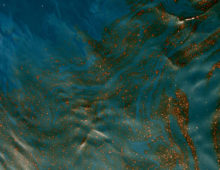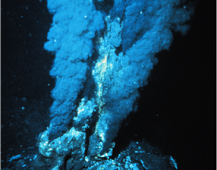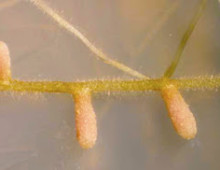The first research effort reported in an article published online June 21, 2012, in the ISME Journal involved samples taken immediately after the Deepwater Horizon spill began and during the ensuing clean up efforts.The researchers found that a variety of microbes consumed parts of the oil spill selectively. Each group of microbes specifically targeted one group of…
Deepwater Horizon cleanup microbes project in Oil and GasOnline
To learn more about the microbial community’s response to the oil spill, researchers led by Berkeley Lab senior scientist Janet Jansson availed themselves of the expertise and resources at two of the Lab’s national user facilities, the U.S. Department of Energy Joint Genome Institute (DOE JGI) and the Advanced Light Source (ALS). The work done…
Some Enzymes Like it Hot
It sounds like a dream vacation: hang out in hot springs all day, converting sugar to alcohol. But that’s precisely what researchers are looking for in microbes to more efficiently break down plant matter into fermentable sugars for biofuel. And they found it in Dictyoglomus turgidum, in samples from Obsidian Hot Spring in Yellowstone National…
Waves of Berkeley Lab Responders Deploy Omics to Track Deepwater Horizon Oil Spill Cleanup Microbes
In the aftermath of the Deepwater Horizon oil spill in the Gulf of Mexico two years ago, various strategies were deployed to prevent 4.9 million barrels of light crude oil from fouling the waters and reaching the shores. A team of Lawrence Berkeley National Laboratory (Berkeley Lab) researchers found that nature also played a role…
Waves of Berkeley Lab Responders Deploy Omics to Track Deepwater Horizon Oil Spill Cleanup Microbes
In the aftermath of the Deepwater Horizon oil spill in the Gulf of Mexico two years ago, various strategies were deployed to prevent 4.9 million barrels of light crude oil from fouling the waters and reaching the shores. A team of Lawrence Berkeley National Laboratory (Berkeley Lab) researchers found that nature also played a role…
“JGI Looking Beyond Whole Genomes” – GenomeWeb’s In Sequence
The Department of Energy’s Joint Genome Institute has already churned out over 40 trillion bases of sequence data this year, using a variety of next-generation sequencers for applications including de novo whole genome sequencing, RNA-seq, ChIP-seq, methylation sequencing, and even some single cell sequencing.While the majority of its work is currently in whole genome sequencing,…
Protein studies offer clues on how palm worms can take the heat
Hydrothermal vents behave like geysers at a national park, except that they erupt deep underwater in the Pacific and Atlantic Oceans. Though the water that shoots out of these vents can reach temperatures as high as 300°C (572°F), many animals and other organisms thrive in the surrounding area. Two such extremophiles are “palm worms,” named…
DOE JGI’s IMG/M data system in Berkeley Lab’s release on the Human Microbiome Project
Berkeley Lab’s role in mapping the human microbiome revolves around big data, both analyzing it and making it available for scientists to use worldwide…. Berkeley Lab scientists developed and maintain a comparative analysis system called the Integrated Microbial Genomes and Metagenomes for the Human Microbiome Project (IMG/M HMP). It allows scientists to study the human microbiome…
Dekkera yeast project in Science Daily
The yeast Dekkera bruxellensis plays an important role in the production of wine, as it can have either a positive or a negative impact on the taste. Researchers at Lund University in Sweden, among others, have analyzed the yeast’s genome sequenced by the US Department of Energy Joint Genome Institute, giving wine producers the possibility to take…
Comparative genomics method to tag novel nitrogen-fixation genes
Nitrogen is crucial for plant growth but plants cannot harness it directly from the atmosphere. In the United States, legume crops such as soybeans and peas rely on nitrogen fertilizers to boost yields; in 2007, 13 million tons of industrially-produced fertilizers were applied. Soil bacteria such as Sinorhizobiummeliloti have a symbiotic relationship with plant hosts…


